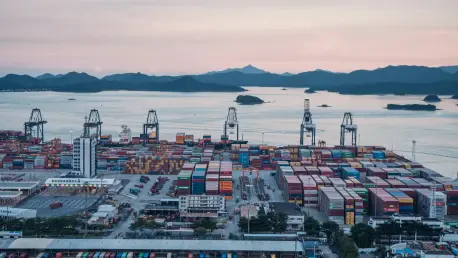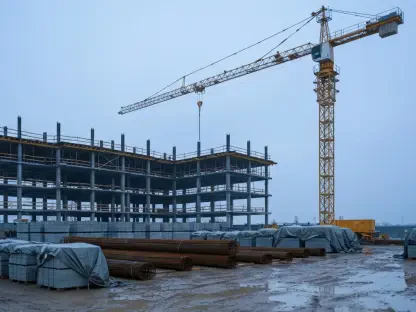In the world of construction and infrastructure, few developments are as ambitious as the new £750M construction framework initiated by Peel Ports Group. To gain more insight into this monumental project, we turn to expert Luca Calarailli. With his extensive background in design, architecture, and innovative technology applications within the industry, Luca offers a unique perspective on what this framework entails and its anticipated impact on the UK and Ireland’s port operations.
Can you explain the significance of the £750M construction framework that Peel Ports Group has initiated?
The £750M construction framework is a massive investment aimed at enhancing and expanding port infrastructure across the UK and Ireland. This initiative underscores the critical role ports play in the region’s trade and logistics. By modernizing and increasing capabilities at various ports, the framework is expected to boost efficiency and support economic growth.
How were the 18 contractors selected for this framework?
The selection process was quite rigorous and focused on identifying the best regional and national partners. Peel Ports Group aimed to choose contractors with proven expertise and reliability to ensure that the projects undertaken would meet high standards and contribute effectively to their strategic goals.
How long is the construction framework set to last, and what does it aim to achieve over this period?
The framework is set for up to eight years. During this time, it aims to carry out a wide range of infrastructure improvements and new developments. This initiative is designed to support the ongoing development of Peel Ports’ network of logistics hubs, thereby enhancing their operational capabilities and capacity.
What are the various lots within the framework, and what specific types of projects do they cover?
The framework is divided into three main lots: Lot 1 covers general construction; Lot 2 is dedicated to marine construction; and Lot 3 focuses on major projects on a national scale. Each lot targets different aspects of port infrastructure to address diverse needs within the facilities.
Could you provide details about Lot 1, which focuses on general construction?
Lot 1 involves a broad scope of activities including the construction and maintenance of roads, carparks, warehouses, and various other infrastructure components. It also covers work related to drainage, earthworks, foundations, and more, ensuring that all general construction needs are comprehensively addressed.
What does Lot 2, which pertains to marine construction, specifically involve?
Marine construction under Lot 2 includes specialized tasks such as quay wall construction, maintenance of lock and sluice gates, and development of RoRo facilities. This lot caters to the unique requirements of marine structures and ensures that port capabilities are enhanced to support maritime operations efficiently.
Can you describe Lot 3, which is designated for major projects, and what types of endeavors it includes?
Lot 3 is primarily for larger, national projects that have widespread impacts across the port operations. These could involve significant infrastructure overhauls or expansions, aimed at elevating the strategic role of the ports within the UK and Ireland’s logistical framework.
What specific projects or sites will these contractors be supporting across the Peel Ports portfolio?
The contractors will be working across several key sites, including the Port of Liverpool, Heysham Port, the Manchester Ship Canal, London Medway, and Dublin Port. Each location has its own set of projects tailored to enhance its unique operational capabilities and strategic importance.
How does this framework contribute to the future development of Peel Ports’ operations and logistics hubs?
By modernizing and expanding port facilities, the framework supports the broader strategic objectives of enhancing operational efficiency and capacity. This, in turn, positions Peel Ports as a more agile and competitive player in the logistics and trade sectors.
What types of infrastructure improvements or new developments are expected under the scope of this framework?
The framework is set to deliver a host of improvements, from new roadways and improved drainage systems to enhanced marine structures and state-of-the-art warehouses. These efforts are crucial in accommodating growing trade volumes and ensuring that the ports are equipped to handle future demands.
What does the general construction scope entail in terms of specific activities like drainage, road construction, and warehouse maintenance?
Activities include comprehensive road construction and maintenance, effective drainage solutions, and rigorous upkeep of warehouse facilities. This ensures that the infrastructure remains resilient and able to support heavy logistical operations over time.
Can you describe the marine construction activities covered by the framework, such as quay walls and RoRo facilities?
The marine construction component focuses on ensuring that the port’s marine infrastructure is robust. This includes building and maintaining quay walls, installing and repairing RoRo facilities, and overhauling critical marine assets like berthing furniture to support larger and more frequent shipping activities.
Who are some of the construction and engineering companies appointed to this framework, and what are their roles?
The framework includes companies like Bachy Soletanche and Glencar, among others. Each firm brings its expertise to specific areas of construction, whether it’s general infrastructure, marine works, or large-scale projects, thus playing pivotal roles in executing the diverse scopes of the framework.
Can you elaborate on Peel Ports Group’s recent investment in Heysham Port and its expected impact?
The £10M investment in Heysham Port is set to bolster its capacity and efficiency. Given its strategic location as a key trade link between the UK mainland and neighboring islands, these enhancements are crucial for facilitating smoother trade operations and accommodating larger cargo volumes.
Why is Heysham Port considered a key trade link, and how does this framework support its strategic importance?
Heysham Port is pivotal due to its connectivity between the UK mainland and the Isle of Man and Ireland. By enhancing its infrastructure, the framework ensures that it remains a vital point for trade flow, supporting its ongoing strategic importance and driving regional economic growth.









